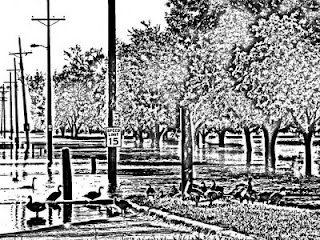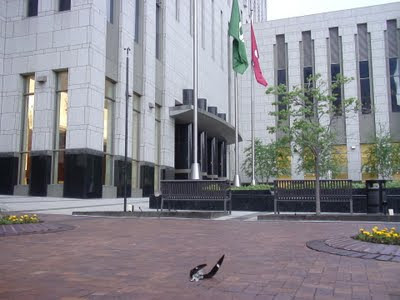It was a swell evening Thursday on June 23. Sky was blue with a few scattered clouds to the south. Winds were calm and it was cool.
Purple Martins were about and it was time to once again check activity at their well known roost.
Wheeling along on two wheels, upon arrival at 44th Street, the setting was just right to view the roost trees lit by sublime evening light, with the buildings shining in the background. There were, however, no birds of interest yet about.
Bicycling further east, time was taken to watch the Chimney Swifts about 40th and Farnam streets. The usual fine bunch was about, including a couple of small groups which had fledglings refining their aerial skills. The bird sort of twittering was all about.
With time available a brief stop was made at the local establishment for a single cool drink with my favorite lemonade mix.
Then onward to the roost site observation location which was being used by three medical center workers on a smoke break. They sat on the steps and babbled on. The fem was the focus of two men's attention. She was fully loaded. There was a pack of cigarettes topped with a lighter, a cell phone, a music player, a bug repeller and a can of soda all carefully laid out in a row on either side. They finally left and the birds, thankfully, became the obvious feature.
About 8:30 p.m. there were 15 or so martins above. On terra firma nearby, several cutesy little bunnies were on the turf, though close to cover. Their parents foray's were a bit further. They were an additional appreciation.
Common Grackles fly around. Some starling were obvious. A few other species were present.
Most noticeably a Red-tailed Hawk, perched on a rooftop edge of the south doctor's building. It had earlier been seen soaring above the scene. Those little bits of rabbit were prime targets for this mighty raptor.
Martin Mecca
With the swarm of martins increasing, another detail was noticed. The measly "decorative" decals were on the glass windows of the walkway, but the banners were not hung with care. This is the danger zone for the migratory birds.
The martin mecca midtown is best appreciated with a personal experience. This particular evening, early in the season had the normal activities which have been observed in the past four years, since my sole discovery of this wonder of the Missouri River valley. Yet! Yes it was a grand spectacle. Once observed in all their glory, the activities are superb in a phantasmagorical mix of bird movement, vocalizations and other general activity by adult and juveniles birds. They are masters through the hidden breezes of the sky.
The hawk just sat there with its own intentions. Occasionally a grackle would swoop nearby to express its displeasure. Two robins were most intent in wanting the hawk gone. One sat within a few feet, trying to harass the raptor to an extent to get it to leave. Another was a few feet further away, providing backup. Near the roost site observation location, a robin was seen carrying food, which readily indicated the reason for robins in action against a predatory intruder among their community.
Once the hawk did finally decide to depart, most of the martin swarm escorted it upon its departure towards the west.
With the descent of dark, more of the munificent martins arrived. The seasonal congregation was underway, and was only being appreciated by a single man, who's presence did not matter in the least to the gathered birds.
What new expressive word should be given here is uncertain. There could be further comments on the splendor, but it was time to cycle onward.
Dangerous Dundee Mishap
Going up the hill to 49th Street there a bit if vibrancy in the pedal motion because of what had been enjoyed. Pedal. Breathe. Pedal. Pedal. Fatigue upon getting to the hilltop.
Going north, the fine night continued across Dodge Street and northward towards the expected destination.
Suddenly a car turned in front of my route. There was a vivid view of a pending collision with no means to stop or avoid the coming hit.
Oh no! Smash ...
The subsequent moments are not part of my awareness. The next cognizant realization was lying on the street, looking at the underside of a car, with the front tire a few feet away. The "wits were gathered" as lying in the street was not the place to be, so my position was moved to the curbside grass to lay back. The "hipster" drivers at least asked once about my situation, then made no further attempts at communicating. A nearby resident offered a cup of water. She had not seen the accident but had heard it.
Yikes. A car and a bike collide with her and other gawkers knowing about it because of the noise. What is it about a guy on a bicycle hitting a car which cut in front of the cyclist that is so obviously noisy?
If the car would have had its headlights on or used its turn signal - neither which was being used based upon quickly made, pre-trauma recollections - it might have been avoided.
There could be a lot to say of what happened next. It all followed an expression to call emergency services. An ambulance and fire truck arrived in minutes.
The responders then took control. Being strapped onto a back board and being asked question after question is not my version of a typical bird watching outing.
My eyes were kept closed except for a few secondary moments, until and into being situated in an emergency room. The stress level was elevated.
There could be comments on being treated as a body instead of a person at the nearby medical center. There was a lack of explanation on the flurry of activites. Their actions were apparently appropriate, but overwhelming. There was the security goon being a "big man" with a shiny "tin" badge. There is the discomfort of being left lying for many minutes on a back board while health care givers discuss my situation in the hall. Money, money, money the basic point. There could be words given about the doctoral discussions, when the two guys finally were cognizant enough to be personable and listen. There were a whole lot of words because of out looking at birds. There is the lack of police providing no information on the car drivers.
There could be more said. There were enough opinions to last a year.
As a hurting hombre, my nights destination was reached a couple of hours later, via my own two feet through the streets. Ow. Oh that hurts. Again and again until the realization most obvious: pain is an active part of life, and this was one of my times. Along the way, notably noticed were small pieces from a broken car - due to blunt force tramua from my body - on north 49th Street. The broken bike - with a dramatically twisted front tire - had already been delivered by three firemen to the front porch, rather than the back year which had been the request, repeated twice.
Conditions due to the accident continue. It is beyond malaise, but an obvious malady with an unknown result(s) pending.
There will certainly be another bicycle visit to the martin mecca? This wonder of the bird world will hopefully be enjoyed again and again in some manner or another.

















